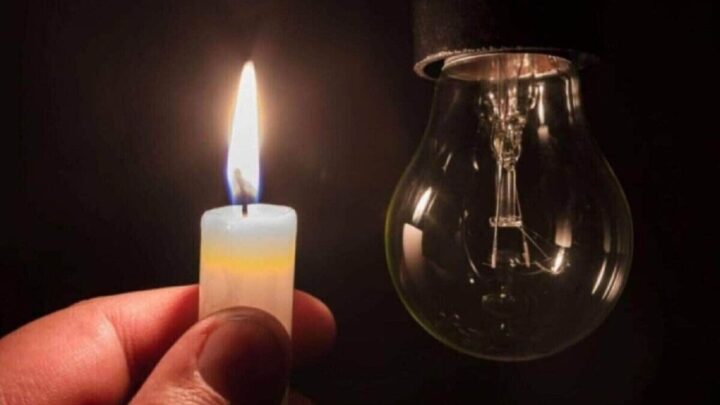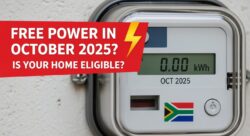South Africa is facing another tough weekend due to Stage 6 power cuts. Eskom made this announcement because they can’t produce enough electricity for everyone. Stage 6 is one of the worst levels of power cuts and means many hours without power. People and businesses will have to deal with long blackouts that mess up their normal activities. Eskom has shared the times when power will be off. Everyone needs to check these schedules and plan their weekend around them. The power cuts will affect the whole country & make life harder for millions of people. South Africans should get ready by charging their devices and planning ahead for the times without electricity.

What Is Stage 6 Loadshedding and Why It Matters Now
Stage 6 power cuts are very serious in South Africa. When this happens Eskom needs to save up to 6000 MW of power across the country. People & businesses can lose power for up to 10 hours each day. This creates big problems for everyone. The power cuts make life hard. Homes can’t use basic appliances. Businesses struggle to stay open. Hospitals and schools face big challenges. Many companies lose money because they can’t work properly. The effects of Stage 6 are:
– Longer blackouts
– More frequent power cuts
– Problems with basic services
– Business losses
– Lower work output
– Higher costs
– Need for backup power
Everyone in South Africa should know what Stage 6 means. It affects daily life in many ways. People need to plan ahead and find ways to cope when the power goes out.
Eskom’s Official Weekend Schedule for Stage 6 Power Cuts
Eskom just shared a new schedule that shows when the power will go off this weekend. The schedule helps people & companies know when to expect blackouts so they can plan better. The power cuts are set up to share electricity fairly between areas and keep the power grid safe. People should check their local times for power cuts to avoid problems. Everyone needs to know when their area will lose power so they can get ready. The schedule makes it easier to deal with these outages and plan daily tasks better.
| Day | Time Slot 1 | Time Slot 2 | Time Slot 3 |
|---|---|---|---|
| Friday | 06:00-10:00 | 14:00-18:00 | 22:00-02:00 |
| Saturday | 08:00-12:00 | 16:00-20:00 | 00:00-04:00 |
| Sunday | 06:00-10:00 | 14:00-18:00 | 22:00-02:00 |

Smart Ways to Prepare for Stage 6 Loadshedding at Home
Getting ready for Stage 6 power cuts helps make them less difficult. Everyone needs a good plan to deal with these blackouts. Both homes & companies can take steps to make power cuts less annoying. Here’s what you can do:
– Buy backup power like a generator or solar setup
– Keep your phone and other important devices charged
– Make food that doesn’t need electricity
– Have enough lights ready like flashlights and candles
– Check the power cut times on websites or apps
These simple actions can help you handle power cuts better. They let you keep doing normal things even when the power is off. The key is to think ahead and be ready before the lights go out. This way you won’t be caught off guard when Stage 6 hits. Remember to check the schedule every day. Power cuts can change quickly. Having a basic plan makes everything easier to manage. You can still live normally if you prepare well.
Best Backup Power Options to Beat the Blackout
More people in South Africa are looking for new ways to get power because of the frequent blackouts. They want to keep their homes and businesses running when the main power is off. These backup power options help people stay comfortable and also take some pressure off the main power grid. Here are the main backup power choices:
– Generators that run on fuel
– Power inverters for basic needs
– Solar panels for your roof
– Batteries to store power
– Backup units for computers and phones
These options can be a big help during power cuts. Each one has its own benefits and can work well depending on what you need. More South Africans are buying these systems to make sure they always have power when they need it.
What the Government Is Doing to Tackle Loadshedding Crisis
The South African government and Eskom are taking steps to fix the power problems in the country. They have created plans to make more electricity and fix old power stations. These plans will help South Africans deal with loadshedding & create a better power supply for the future. The main focus areas are:
– They are building new solar and wind farms to add clean energy
– They are fixing and upgrading current power stations
– They started programs to help people use less electricity
– They are working with private companies to find new solutions
– They changed some rules to get more companies to invest in power
– These changes won’t fix everything right away but they show that there’s a plan to make things better.
The government wants to end loadshedding & give everyone reliable power. They know it’s important for daily life & the economy. While it will take time people can see that work is being done to solve the electricity crisis.
Economic Shockwaves: How Stage 6 Affects South Africa’s Growth
Loadshedding hurts South Africa’s economy in many ways. When the power goes out businesses can’t work properly and lose money. Small shops and big factories both suffer because they need to buy expensive generators and fuel to keep running. Many workers sit idle during blackouts which means less gets done each day. The power problems also make foreign companies think twice about investing in South Africa. They worry about their machines stopping and workers not being able to do their jobs. Manufacturing takes the biggest hit since production lines need constant power. Service businesses like restaurants and stores also struggle when the lights go out. The backup power systems are very expensive to buy & maintain. This makes running a business in South Africa cost more than in other countries. The end result is that the whole economy grows slower because of these ongoing power cuts.
Local Heroes: Community Strategies to Fight Loadshedding
South Africans are dealing with tough power cuts during Stage 6 loadshedding. People are working together to handle these blackouts in their towns and cities. Many neighborhoods have started helping each other out. This shows how South Africans can adapt when times get hard. Some areas have set up power-sharing between homes. Others teach people how to save electricity. Many streets now have teams that keep watch when the lights go out. Neighbors share their backup power systems like generators and solar panels. Local groups also push the government to fix the power problems faster. These team efforts do more than just help with power issues. They bring people closer and create stronger communities. When people work together they can handle big problems better. South Africans keep finding new ways to beat the darkness.
Future Hope: Innovative Renewable Energy Projects in Progress
Renewable energy is becoming more popular in South Africa as the country faces power problems. New technology has made clean energy cheaper and easier to use than before. Solar panels and wind turbines are now better options compared to old ways of making electricity. Many people are switching to these energy sources because they work well and help protect the environment. South African companies are starting to build more solar farms & wind projects across the country. This shift to renewable energy could help fix the frequent power cuts that affect daily life. The government is also supporting these changes by making new rules that encourage clean energy use. As more people choose renewable power South Africa’s energy future looks brighter. These solutions are good for both the economy and the planet. The country can now start moving away from its dependence on coal power plants.
| Renewable Source | Advantage | Implementation | Cost |
|---|---|---|---|
| Solar | Abundant and sustainable | Residential and commercial | Moderate |
| Wind | Low environmental impact | Large-scale projects | High initial |
| Hydro | Reliable and efficient | Rivers and dams | Varies |
| Biomass | Reduces waste | Industrial | Moderate |
| Geothermal | Constant energy supply | Geothermal sites | High |






